



少林拳源于少林寺,拳因寺而得名,故名少林拳。少林拳是少林 拳术和器械的总称。少林寺位于我国河南省登封市境内,在登封市西 北约13公里处,是公元495年北魏孝文帝为来中国传教的印度僧人跋 陀所建造。由于寺建立在嵩山支脉少室山阴的密林丛中,故名嵩山少 林寺。
Shaolin Boxing is originated from the Shaolin Temple. It is named Shaolin Boxing due to the name of the Temple. Shaolin Boxing refers to both the Shaolin martial arts and weapons. Shaolin Temple locates in Dengfeng City, Henan province, about 13 kilometers away to the northwest of Dengfeng City. In 495, the Emperor Xiaowen of the Bei-Wei Dynasty constructed it for the Indian missionary monk Batuo. Since the Temple was built in Songshan offshoot, it is named Songshan Shaolin Temple.
关于少林武术的产生,世人有许多说法,但真正有据可信者应从 隋唐讲起。
There are many stories about the origin of Shaolin Wushu, but the credible evidence should start from Sui and Tang dynasties.
隋末唐初(公元620年),李渊、李世民父子为了争霸天下,与 盘踞在洛阳的隋朝大将王世充交战。在战斗的紧要关头,以昙宗为首 的少林寺僧,活捉了王世充的侄子王仁则,并将其捆绑送至唐营,立 了大功。李世民登基之后,“嘉其义烈,颁降玺书宣慰”(少林寺碑),对立功和尚各有赏赐,其中昙宗被封为大将军。这次战斗,给 了少林武僧习武成名的机会,揭开了少林武术光辉灿烂的一页。少林 寺发展很快,名声日隆。贞观以后,少林寺僧“昼习经曲,夜练武
修文不忘武备”(西来堂志善碑),修佛习武成了少林寺世代相 传的独特宗风。
In 620, Li Yuan and Li Shimin fought against the general of the Sui Dynasty-Wang Shichong in Luoyang, in the crucial moment of the battle, Tan Zong headed Shaolin monks to arrest Wang Shichong nephew-Wang Renze, and sent him to the Tang camp. After Li Shimin became the emperor, he rewarded the monks for their help, and Tan Zong was awarded the title of the General. This battle made Shaolin monks famous for their boxing. From then on, Shaolin martial arts had a glorious start. Afterwards Shaolin Temple has developed rapidly, its reputation has grown. After the Zhen Guan period, Shaolin monks wread the Buddhist books in the day, practiced martial arts in the night, while studying the Buddhist books, they didn forget military preparations?(from Xilai Tang Zhishan Tana-Monument). Studying the Buddhist books and practicing martial arts have become the unique Shaolin style passed on from generation to generation.
北宋年间,福居和尚做少林住持时,曾邀请全国武术名流云集少 林寺,虚心与各派切磋技艺。北宋末年,金兵南侵,少林寺武僧宗印 受命率“尊胜队”和“净胜队”两军,进发潼关,与金兵对垒,报效 国家。
In the Northern Song period, Fu Ju, the headmaster of Shaolin Temple, invited national celebrities in martial arts to Shaolin Temple in order to learn from each other. When Jin army invaded the Northern Song, the Shaolin monk Zong Yin was appointed to command unsheng team?and ingsheng team?to fight against the Jin army in Tongguan, serving the country.
元朝,崇尚释教,少林寺与皇家关系也十分密切,元世祖命福裕 大和尚住持少林寺,并统领嵩岳一带所有寺院。此时的少林寺,众常 两千。寺僧习武队伍中,如智庵、智聚、子安、党训等,都是当时身 怀绝技的名僧。
In Yuan dynasty, because Buddhism was popular, Shaolin Temple maintained close to the Royal, the Mongol emperor appointed Fu Yu to chair Shaolin monks and lead all the monasteries in Song Mountain area. At that time, the Shaolin Temple had 2,000 monks, among which Zhi An, Zhi Ju, Zi An and Dang Xun were very famous Monks in martial arts.
明代,少林武术蓬勃发展,誉满天下。少林棍在少林武术中占有 重要地位,少林僧所使用的兵器以棍最为闻名。《武备志》作者茅 元仪对少林棍给予了很高的评价。他认为“诸艺宗于棍,棍宗于少 林”。特别是在抗倭卫国的战争中,以棍为杀敌武器的“本寺武僧屡 经调遣,奋勇杀敌”(少林寺万历二十三年七月碑)。“俱持铁棍长 七尺,重三十斤,运转便捷如竹杖,骁勇雄杰,官兵每临阵,辄用为 前锋……抡棍破敌,与者即仆,顷刻毙数倭”(《上海掌故丛书•吴 淞甲乙倭变志》)。少林僧为国为民的英烈壮举谱写了一曲曲动人 的、可歌可泣的雄壮诗篇。
In the Ming Dynasty, the Shaolin martial arts flourished and became famous in the world. The Shaolin stick held an important status in the Shaolin martial arts, which was also known as the most famous enginery for the Shaolin monks. Mao Yuanyi,author of the book highly praised
the Shaolin stick. In his opinion, w Stick is the ancestor of all martial arts, and Shaolin is the cradle of the stick.?Especially in the Anti-Japanese Pirate War, stick was recorded in the weapon in July, 23 of perpetual calendar of Shaolin Temple stele as ur temple monks were maneuvered for several times and fought against the enemy bravely.?Another record in the Shanghai anecdotes series-Wusong says WA11 of them held the stick which was 7 feet long, 30 jin in weight, and swift like the bamboo rod. The warriors were so brave that if any soldier be ahead of the war field,he would act as a vanguard - ?The Shaolin monks wrote many moving and praisable glorious epics which record their great behaviors for the nation and people.
清代,少林寺习武之风极盛。今之少林寺毗卢阁(又名千佛殿) 内青砖地面上尚存的当时寺僧练功形成的48个凹陷脚窝,就是少林寺 武僧长期从事武功训练的有力佐证。
In the Qing Dynasty, the fashion of learning Shaolin martial arts was prevailing. Today's Shaolin pilu pavilion(also named Qianfo palace) still keeps the 48 hollow foot-making holes of the monk on the grey brick field, which is a strong evidence of the long time training of Shaolin monks.
民国时期,少林武术曾是“国术研究馆”主要学习和研究的内容 之一。然而由于当时军阀混战,给少林寺带来了灭顶之灾。1928年, 国民军冯玉祥部石友三与建国军樊钟秀战于河南,石友三攻占少林寺 后,为泄私愤,便纵火焚寺,大火持续40余天,殿堂楼阁等古建筑全 被夷为平地,大量珍贵文物也一同化为灰烬。
During the period of Republic of China, the Shaolin martial arts were once one of the mainly studied and researched contents of he Museum of National Martial Arts? However,the dogfights of the warlords at that time destroyed Shaolin Temple. In 1928, Shi Yousan, who belonged to the department of Feng Yuxiang of Kuoming Tang fought with Fan Zhongxiu, who belonged to the Jianguo army. Shi set fire on Shaolin Temple to give vent to his personal rage after attacking and occupying it. The fire lasted for more than 40 days, which destroyed all the constructions and precious cultural relics in the temple.
新中国成立后,少林寺和少林武术又获得了新生。党和政府不但拨 专款修复少林寺,而且对少林武术的发展也十分重视。特别是1982年, 香港中原影业公司功夫片《少林寺》的公映,使少林武术兴旺空前。
After the foundation of the Peopled Republic of China, both Shaolin Temple and Shaolin martial arts get their new lives. The Party and government not only allocate exclusively to rebuild Shaolin Temple but also pay much attention to the development of Shaolin martial arts. 1982 should be mentioned, as the film Shaolin Temple produced by HongKong Zhongyuan Film Company was released to the public, which made the Shaolin martial arts reach its climax.
少林拳是中华武术中一大派系,其内容丰富多彩。目前社会上广 为流传的典型拳路就有大洪拳、小洪拳、炮拳、罗汉拳、朝阳拳、梅 花拳、通背拳、长拳、关东拳、长护心意门、七星拳、心意拳、柔 拳、少林太极拳,以及各种器械、对练等。另外,还有与养生功、医 学、气功等有关的内容,都是十分宝贵的民族传统文化。
The Shaolin Boxing is one of the biggest section of Chinese Wushu. It is rich and colorful in contents. At present, the polular typical boxing routine includes Dahong Boxing, Xiaohong Boxing, Pao Boxing, Luohan Boxing, Zhaoyang Boxing, Meihua Boxing, Tongbei Boxing, Chang Boxing, Guandong Boxing, Changhuxinyimen Boxing, Qixing Boxing, Xinyi Boxing, Rou Boxing, Shaolin Taiji Boxing, and other different kinds of appliances and combats. Whafs more, there are some contents which are relevant with health preserving Kongfu, medicine, and Chikung, etc. They all belbng to the very precious national cultures of tradition.
少林拳的特点
少林拳朴实无华、立足实战,其运动特点也具有鲜明的技击性。
Shaolin Boxing is unvarnished, basing itself upon actual combat, and also has the distinctive characteristic of technical attack.
拳打一条线,拳打卧牛之地。
To punch out straight like a line, and to practice punching even in someplace only available for the cattles.
少林拳套路繁多,结构紧凑,短小精悍。演练时,起落进退多在 一条线上运动。众多少林拳家认为,从实战角度出发,真正交手相搏 无非几步之距,直线运动最为有效,方寸之间便有胜败之分。这充分 体现了少林拳不受场地大小限制,随时随地均可施展解数和发挥威力 的特征。
Shaolin Boxing has various sets and compact conformation, which is short but strong enough. When exercising, the movements up and down are almost in a line. Lots of masters of Shaolin Boxing believe that from the practice point of view,two people in a fighting encounter are only apart from each other for several paces, which means that the linear movement that division victory and defeat in a second is the most effective one. All above show fully that Shaolin Boxing is not restricted by the size of field, and its skills and power can be displayed anytime and anywhere.
动作迅猛,快速有力。
Move rapidly, quickly and forcefully.
少林拳要求刚健有力、迅速激烈,即所谓“起手连珠炮,拳打一 气连”,“使势千着,以快为先”。在套路演练过程中,要求几个或 十几个动作连贯快速,一气呵成。少林拳虽以刚为主,但同时也要求 刚柔相济。“刚在他力前,柔在他力后”,动如风,站如钉;重如 山,轻如毛;守之如处女,犯之若猛虎;静则以逸待劳,动则使其无 喘息之机;如此等等。
Shaolin Boxing demands be energetic, powerful, and rapid actions, which is o start boxing with bombards, and to get it done without any letup?; he rapidness is before all in thousand boxing movements?. In the process of routine drilling, tens and several movements are required to be finished in a coherent and rapid way. Although Shaolin Boxing focuses on the firmness, it should be supported by flexibility. irmness comes first, and then flexibility.?To move like the wind, and to stand like the peg. Be heavy as mountain, light as feather. When defending, be as a virgin, when assaulting, like a tiger. Motionless is to wait at its ease for an exhausted encounter, and moving boxing makes the encounter be out of rest, etc.
曲而不曲,直而不直,滚出滚入,富有弹性。
Curl and straight both don^ always take their course, and the hand movements are full of flexibility.
就手法而言,少林拳要求两臂保持一定曲度,冲拳推掌,须蹬腿 转腰、抖肩发力。“身以滚而动,手以滚而出”,反对僵直拙力。在 完成动作的一瞬间,依手臂的自然反弹力,使手臂形成曲非曲、直非 直的态势,为继续攻防创造便利条件。滚出滚入,更是攻防技术的科 学反映,旋动可增强攻击力,滚动也有利于化解对方之力。
As for the hand skills, Shaolin Boxing requires the two arms to keep a certain degree of curvature. When striking a fist and push a palm, the legs should be driven, the waist be turned, and the shoulder be shaken powerfully. he body moves
according to the hand's rolling movements, which abides by the rolling movements of itself.?Ankylosis and clumsiness are not allowed at all. At the very moment of finishing, the arms should form some kind of posture that is not so curl or so straight to create further condition for another convenient attack and defense. The rolling movements are even the scientific reflects on the technology of attack and defense, for the rolling can accumulate the power of attack, and is good for the defense to dissolve the attack.
眼法以目注目
Eyes on eyes as the eyes skills.
少林拳对眼的要求是必须头随势转,手到眼到,以目注目,“以审 敌势”。演练少林拳,眼要明亮有神,眼明方能手快。“虎视眈眈,气 息沉沉,目光烟烟,含有神威”,显示°出戒逼人之势。
The requirements of Shaolin Boxing for eyes rely on the head movements according to the posture, the eyes?trace for the hand, and eyes on eyes to scan the enemy. When practicing Shaolin Boxing,one eyes should be as sharp as possible to make the movements rapid. e hostile in gaze,calm in mind,bright in eyes, and divine in temperament,which then can result in aggressive vigour.
交手,不是注意对方手和身躯,而是观察对方眼神,以目注目, 算计对方。
When fighting against each other, one pays his attention to the other's expression in his eyes, not his hands and body, to plan the next step.
进低退高,起横落顺。
To be balanced in body movements, and flexible in foot movements.
少林拳要求进攻时力求重心稳固,身正发力,以加强进攻力度。 防守动作则要求动作灵活,灵敏快速。凡退凡落多要求侧面对敌,以 缩小受击面,便于防守与进攻。
When attacking, Shaolin Boxing requests the firm barycenter and straight
body to exert force, which can also increase the attacking power. When defense, it requests flexibility and rapidness. In a word, the defensing movements mostly require side posture to reduce the scope of attacked area and be good for further defense and attack.
注重内外三合的协调配合,以气催力。
To pay attention to the harmony cooperation of the Three Inside and Three Outside combines, and to exert force by breathing.
内外合一、形神兼备是少林拳整体动作的特点。每个招式都必须 做到手到、眼到、身到、步到,周身各部位密切配合,协调一致。 由于少林拳动作紧凑,不易大开大合,所以对身体也有相应的具体 要求,“肩与胯合,肘与膝合,手与足合”,即所谓“外三合”。少 林拳把思想比作心,“心动勇气生”,“心一颤,四梢皆至,内劲即 出”,“心动必形随”,“心与意合,意与气合,气与力合”,即所 谓“内三合”。少林拳谱中称:“法是拳,力是气,练气行动,送去 必用呼,接来必用吸,运气贵乎缓,用气贵乎急,气在先行,力在后 随。”实际上是讲技击格斗和套路演练中意识与行动的高度统一。
Internal and external integration, and unity of form and spirit is the characteristics for the whole Shaolin Boxing movements. Each posture must move hands, eyes, body, and feet to make the whole closely cooperate and coordinate with each other. As Shaolin Boxing moves the entire body compactly and is difficult to open a large, the body has a corresponding specific requirements: uThe hip and shoulder, elbow and knee, hand and foot should combine with each other.?which is the so-called inside three combines. Shaolin Boxing takes the thoughts as the heart, ourage will form if heart beats.?f heart beats, the four extremity get its beat and the internal power comes out?ody movements trace back the heart beats.?eart and will combine,the same with will and breath, and breath and strength/1 which is the so-called outside three combines. The Shaolin Boxing chart says, uFist is the law, and breath is the strength. When exercising breathing in motions, intake and outtake of breath should abide by the movements. The intake of breath relies on the slowness, and the outtake hurry. Breath is always before the strength.?In fact it tells that the highly unification of consciousness and acts in the technical fighting and routine practicing.
以声助威。
Boost the morale of boxing by roaring.
少林拳的演练过程中还有一个发声特点,这就是以声助威。通常 演练者除了在套路结尾时随最后的动作发声“威”夕卜,演练过程中也 常有“呀” “呜”“哈”等不同发声。这些发声源自腹腔,短促有 力,吼声如雷,富有震撼感。
There is another articulation feature of Shaolin Boxing, which is to boost the morale of boxing by roaring. Usually apart from ending the exercise routines with the final articulation of ei?, the course of this exercise can often be heard of a?, oo?and ah?. These articulations are from the abdomen, short but powerful, thundering, rich and shocking.
少林拳基本动作与方法
手型
Hands
拳 Fist
五指攥紧,拳面要平,栂指压于 食指、中指第二指节上。(序图1)
Clenching five fingers, fist face is plane, thumb pressure on the index finger, middle finger. (Picture 1)
掌 Palm
(i)柳叶掌:拇指内屈,其余 四指伸直并拢向后伸张。(序图2)
Willow palm: Bend within thumb and the remaining four fingers unbend backward done. (Picture 2)
(2 )八字掌:拇指伸直,虎 口张开,其余四指伸直并拢向后伸 张。(序图3)
Finger-palm: Thumb extension, the thumb keeps apart with others and the remaining four fingers unbend backward done. (Picture 3)
(3 )分指掌(透风掌):五指 用力分开,掌心微凹。(序图4)
Ventilating palm: The five fingers force separation, palm slightly concave. (Picture 4 )
勾 Hook
(1)屈腕,五指撮拢。(序图5)
Flexor carpi and five fingers gather. (Picture 5)
(2)屈腕,拇指与食指、中指撮 拢,无名指、小指依次内屈。(序图6 )
The wrist bend and the thumb, index finger, middle finger gather, the ring finger and pinkie bend within. (Picture 6)
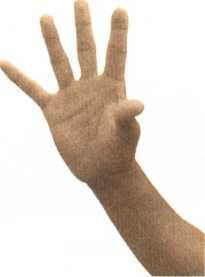
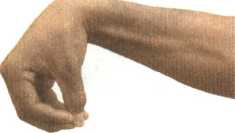
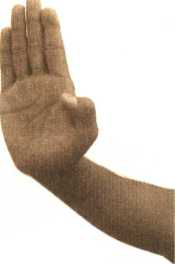
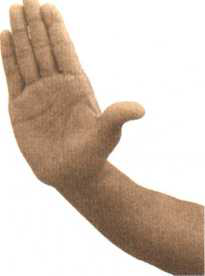
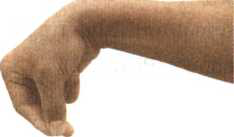
爪 Claws
五指有力分开,第二、三节指 骨弯曲,第一节指骨尽量向手背的 一面伸张,掌心凸出。(序图7)
Five fingers forcefully separated, the second and three phalange bend, first phalange tries to hand back side, palm out. (Picture 7)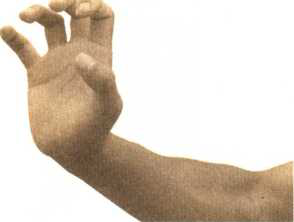
指 Finger
中指与食指伸直自然分开,其 余三指屈于手心,拇指压在无名指 第一指节上。(序图8)
The index finger and middle finger extended naturally and separated, other three of its bend in the palm and thumb pressure in the ring finger on the first knuckle. (Picture 8)
二、步型
Step
弓步 Bow Stance
前脚微内扣,全脚掌着地,屈 膝,大腿水平,膝部与脚尖垂直; 另一腿挺膝伸直,脚尖里扣斜向前 方,全脚掌着地(两脚间距三脚半 左右)。(序图9)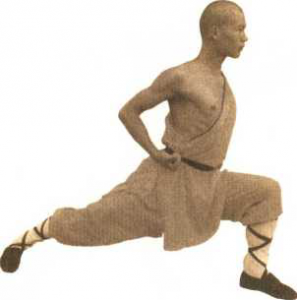
Foreleg is within micro-clasp, a foot down, squat knees, thighs higher level, knee with toe vertical; another leg is straight knee, toe within oblique forwards, the whole foot down (The feet keep spacing with three-legged semi-feet). (Picture 9 )
马步 Horse-riding Step
两脚左右开立,脚尖微内扣,屈 膝半蹲,大腿接近水平。(序图10)
Stand opening, toe within micro- clasp, squat knees, thighs close to the level. (Picture 10)
仆步 Crouch Step
一腿屈膝全蹲,大腿和小腿靠 紧,全脚掌着地,膝与脚尖稍外 展;另一腿平铺接近地面,全脚掌 着地,脚尖内扣。(序图11)
One leg fully squats, thigh and leg together, a whole foot down, knee and toe slightly outreach; another leg is straight close to the ground with the whole foot down and toe within deduction. (Picture 11 )
虚步 Empty Step
后脚尖斜向前,屈膝半蹲,大 腿接近水平,全脚掌着地;前腿微 屈,脚面綳紧,脚失虚点地面。
(序图12)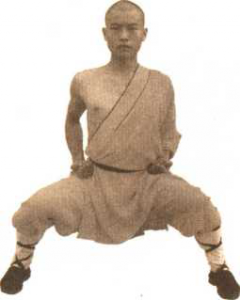
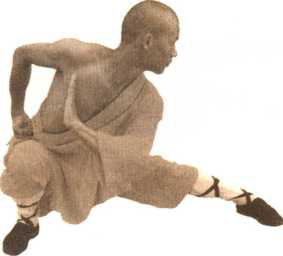
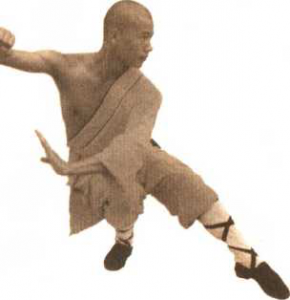
The toes of back foot forward, knee squats, the thigh closes to the level with ground, entire foot down; front leg slightly bends, foot back straight and his toes point empty on ground. (Picture 12 )
歇步 Cross-legged Step
两腿交叉屈膝全蹲,前脚全脚掌 着地,脚尖外展;后脚脚后跟离地, 臀部外侧紧贴小腿。(序图13 )
Cross legs all squat knees, the forefoot whole foot touchdown, toe outreach; back foot heel is part from ground, the buttocks besides close to the gaskin. (Picture 13 )
坐盘 Cross-legged Sitting Position
两腿交叉叠拢下坐,臀部和后 腿的大小腿外侧及脚面均着地;前 腿的大腿靠近胸部。(序图14 )
Legs under cross-sitting, buttocks and back leg touchdown; the thigh of front leg is near chest. (Picture 14 )
丁字步 T-wordStep
两腿并拢半蹲,一脚全脚掌着 地,另一脚脚尖点地,靠在支撑脚内 侧,支撑腿大腿成水平。(序图15)
Legs together half-squat, one foot on ground, toes point of other foot on ground, keep to insides of the supporting legs, the supporting leg thigh into level. (Picture 15 )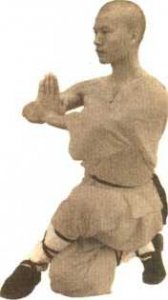
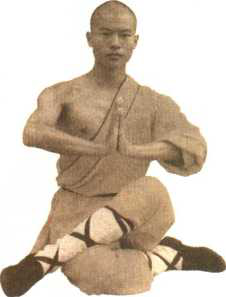
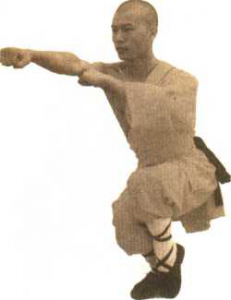
蹲桩步 Crouch Stake Step
(1 )椅子桩:两脚并拢,两腿 屈膝半蹲,大腿接近水平,全脚掌 着地。(序图16 )
Chair stake: Legs together, two legs bend half-squat, the thighs close to the level, all foot to ground. (Picture 16 )
(2 ) —字桩:两脚全脚掌着 地,前后并扰,一脚脚尖靠在另^一 脚内侧脚弓处,两腿屈膝下蹲,大 腿接近水平。(序图17)
One word stake: Feet touch the ground, front and back together, and one foot toe takes in the other foot arch, legs go down on his knees and squat, close to the level of the thigh with ground. (Picture 17)
9•并步 Feet Together
两腿伸直并拢,全脚掌着地Q
Legs stretch out and together, all foot down.
蹲歇步 Crouch and Cross- jigged Sitting Position
一腿屈膝下蹲,全脚掌着地, 大腿与小腿靠紧;另一脚向后相 距30厘米屈膝下蹲,小腿与地面平 行,后脚跟离地。(序图18)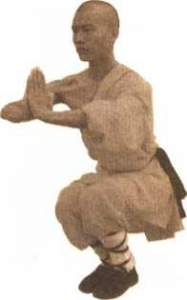
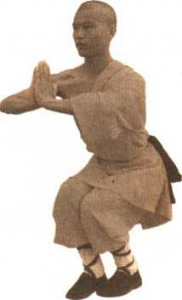
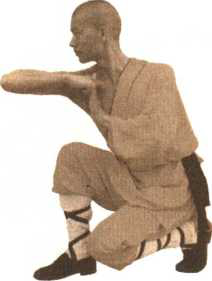
One leg squats, the whole foot down, thigh and calf close, and the other foot keeps 30 centimeters away and bent knees, squat, calf parallel with the floor, back heel away from the ground. (Picture 18)
后点步 Touch Toe Backward
两腿直立交叉,后脚以脚尖点 地。(序图19)
Legs straight and cross legs, back foot toe touches ground. (Picture 19)
跪步 KneeStand
一腿屈膝半蹲,全脚掌着地, 大腿成水平;后腿屈膝跪地,脚后 跟离地,前脚掌着地。(序图20)
One leg bends and half-squats, with the whole foot to ground, thigh into level; back bent kneel genuflects down, the heels up, sole of the forefoot landing. (Picture 20)
横裆步 HorizontalCrotch Step
两脚左右开立,约同弓步宽, 全脚掌着地,脚尖正向前方。(序 图21 )
Legs open, about the same width of bow step, with the whole foot down and toe positive front. (Picture 21)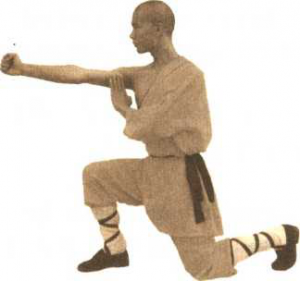
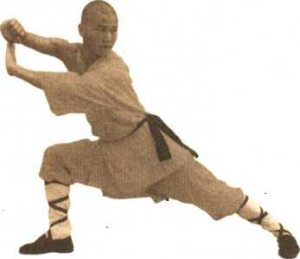
三、手法
Hand Position
拳法 Fistposition
抱拳:两臂垂直上提,同时两手变拳抱于腰间,拳心向上。
Hold fist: Arm raised, at the same time change fist with both hands at his waist, fist-palm upward.
(2 )冲拳(前冲、侧冲、上冲):拳从腰间旋臂向前快速击出, 同时自然弹回使手臂微屈,力达拳面。侧冲、上冲要求同此,唯方向 不同。
Thrust fist (thrust forward, thrust side, thrust up ): Punches from the waist, at the same time naturally recoil and slightly bent arm, strength to face. Thrust side, thrust up as the same requirements of this, but in different directions.
抄拳:臂微屈,拳自下向前上方抄起击打,高不过胸,拳背 向前,力达拳面。
Copied fist: Arm slightly bent, punches forward from down to up beating, fist with chest high, fist back forward, power punches to face.
撑拳:拳肘相并,屈臂从胸前向前向后侧击出,双臂成弧 形,拳心向下,拳眼相对,力达拳轮。
Pillared fist: Fist and elbow are together, bent arm and aparting punch side from the chest, curved arms, fist heart down, fist-eyes face to face, power punches to face.
栽拳:臂由屈到伸,自上向下或由前向下栽。速度要快,前 臂内旋,拳眼向内,臂伸直或微屈,力达拳面。
Planting fist: Arm is from flexion to extension, since the upward to downward or from forward crashed. Faster rate, forearm rotation, fist-eye inward, arm unbend or slightly curly, power punches to face.
架拳(左架、后架):一拳架于额前上方,肘微屈成弧形, 臂与前额相距约15厘米,拳眼向下。
Raise fist (left raise, back raise ): One fist raise his forehead, elbow slightly curly, arm and forehead are about 15 centimeters long, fist-eyes downward.
劈拳:拳自上向下快速劈击,臂伸直力达拳轮。抡臂劈击时 臂要抡圆。
Cut fist: Fist cuts rapidly downward, arm unbends and power punches to face when moving into a round to punch.
裹拳:双拳从腰间屈臂成弧,侧向内击,拳面八字形相对, 力达拳楞(指第二关节楞)
Parcels fist: Fists from the waist flex into arc, side punch, fist face eight-word face to face, power punches to the second comer joints of fist.
(9 )格拳 Parry fist
上格拳:拳从腰间由腹前屈臂向上,然后外格,拳心向内拳面向 上,力达前臂,拳高不过眼。
Parry fist up: Punches from the waist by abdominal, arm bent up, then, block out, fist-heart inward, fist-face up, power punches to forearm, lever with eyes.
下格拳:小臂向里向外格击,力达小臂。
Parry fist down: Arm lattices inside to the outside to blow up power forearm .
(10)挤手抱拳:一手为掌,一手为拳,两手相击,即拳面与掌 心抱击。
Crowded hand and hold fist: A hand to palm, a hand to fist, dual hands attack that fist surface and fist-heart hold down.
(11)截把拳:右臂屈90。于胸前,手心向上,左臂屈臂于右手前 方,手心向上,两手同时变拳,右拳从下左拳从上盘截击出,右拳在前左拳在后,双拳拳心向下。
Intercept handle fist: Right arm bent 90?in front of the chest, palms upward, the left arm flexed on the front right hand, palm upward, at the same time the hands change to the fist, right fist downward and left fist upward punch, right ahead and left posteriority, fist-heart of the double fists downwards.
夹裆拳:拳由胸前直臂向下挂于裆前,拳背向外。
Lock crotch fist: Arm straight punches that fist from chest down in the crotch, fist back outside.
反背拳:拳于胸前,拳背向前,拳心向内,以肘为轴向前 弹击。
Punch back fist: Fist in front, fist back forward, fist-heart inward, swinging elbow forward to attack.
2.掌法 Palm position
推掌:掌由腰间旋臂向前立掌推击,臂微屈,速度快,力达 掌根或掌外沿。
Push palm: Push forward, palm-up from his waist forward, arm slightly bent, power punches to palm root or palm edge.
插掌:臂由屈到伸,直腕向下(向前)插掌,力达指尖。
Trust palm: Arm is from bent to straight, straight-wrist downward trust, power punches to fingertip.
砍掌:臂由屈到伸,仰掌向左,俯掌向右击打,力达掌外沿。
Cut palm: Arm is from bent to straight, palm-up leftward punch, palm-down rightward punch, power punches to palm edge.
按掌:自上向下按,手心向下,力达掌心。
Press palm: Press palm up to down and palm-heart downward, power punches to palm-heart.
撒掌:屈臂向地面抓屈五指,变拳屈臂于胸前,快速伸臂, 拳变掌向前抖腕撒出。
Spreading palm: Bend arm to the ground, grasp flexor five fingers and change fist bend to front-chest, rapidly make a long arm, fist changed palm forward punch.
架掌:掌心向上,屈臂架于额前上方约15厘米处。
Raise palm: Palm upward, bent arm raises above the amount of about 15 centimeters.
扳掌:屈臂内收,掌经胸前,以肘关节为轴向前弹击。五指 自然分开,掌心向内,力达掌背。
Plate palm: Bend arm inside, palm by chest and elbow punches forward. Five fingers to separate natural, palm inward, power punches to palm-back.
枪手:双掌手心向上,从腰间向前上方插出,力达指尖。
Spear hands: Raise palms upward and forward from the waist, power punches to fingertip.
浏览2,660次